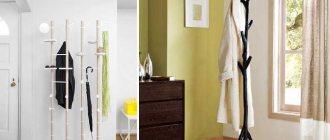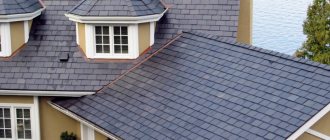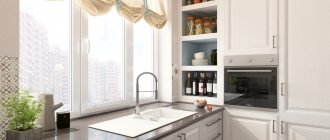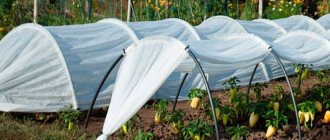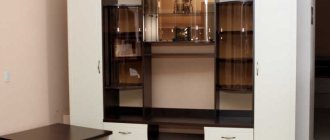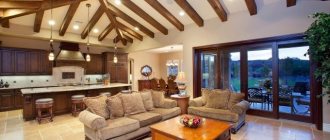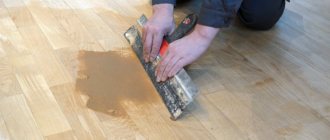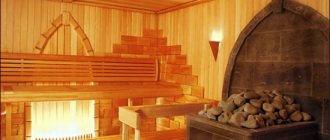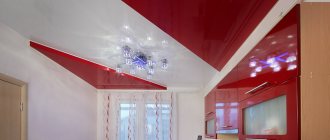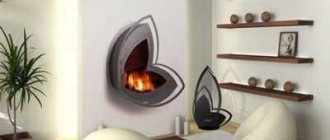Features of cucumber greenhouses
It’s not for nothing that experienced summer residents try not to plant cucumbers and tomatoes in the same greenhouse - they need different conditions for normal vegetation and fruiting. Therefore, when deciding how to build a greenhouse for cucumbers, it is necessary to take into account the peculiarities of their agricultural technology.
- Square.
Plants are very demanding on the composition and nutritional value of the soil, good lighting, so each of them needs a lot of space. This means that the shelter must be spacious enough. The area depends on the number of bushes planted.
- Height.
The fruits are tied on long vines, which must be tied in a vertical position. The height of the greenhouse should allow this to be done. As a rule, borage plants are built no lower than 1.5-1.7 meters. In addition, the design provides for the possibility of installing supports or attaching twine and netting.
Garter of cucumbers in a greenhouse Source homeli.ru
- Ventilation and sun protection.
A sharp change in temperature is detrimental to these plants, so before you make a greenhouse for cucumbers with your own hands, you need to think about a way to ventilate and shelter the plants from scorching rays on sunny days.
- Watering.
Coming from tropical countries, cucumber loves not only warmth, but also high humidity in the air and soil. To prevent them from drying out, it is advisable to equip the greenhouse with automatic watering. Especially if you only appear at the dacha on weekends.
Advice! The ideal solution would be to automate all systems - lighting, ventilation, humidity control, etc. But this is profitable only for large volumes of growing vegetables in permanent greenhouses.
Automatic windows maintain optimal humidity and temperature in the shelter Source vasha-teplitsa.ru
Polycarbonate greenhouse
Polycarbonate is a synthetic material that was obtained specifically for agricultural needs. Its widespread use began about 40 years ago and today polycarbonate is constantly used in growing various crops.
Cellular polycarbonate was invented in Israel for the construction of greenhouses
Polycarbonate greenhouses have a transparency of 80-85%, are resistant to hail and snow cover and have a minimal heat transfer coefficient (that is, they cool very slowly).
Polycarbonate greenhouses are supplied ready-made
When installing a polycarbonate greenhouse, you need to consider several points:
- sheets of cellular polycarbonate should be 4-6 mm thick;
- For proper cultivation, cucumbers need not only light and warmth, but also air with regular watering. Therefore, when creating a greenhouse, consider a ventilation and watering system;
- polycarbonate can be cut perfectly with a sharp knife, but be careful - you can scratch the surface;
- use the material sparingly so that there is minimal waste;
- The surface of the greenhouse should be wiped with a damp cloth, without using any cleaning agents - they will quickly make the polycarbonate cloudy and lose its attractive appearance.
A small polycarbonate greenhouse with a hinged lid suitable for tall plants
Buy or build
Today you don’t have to think about how to build a borage garden with your own hands, but simply buy a ready-made prefabricated structure. There are options for sale in any size and shape, from different materials. In addition, you can order production and assembly on site. There would be money.
It is the high cost of such products that most often forces summer residents to start constructing greenhouses on their own. Or the inability to select a design with the required parameters among the finished products.
Homemade greenhouses are primarily about saving money, since you can use existing materials left over from building a house and other buildings. Their shape, size and equipment will meet the owner’s needs. But implementing such an idea is much more difficult, because it will require design calculations, selection of materials and, of course, certain labor costs.
The finished greenhouse is easily assembled from individual elements according to the instructions Source gardeck.ru
If these difficulties do not scare you, and you want to figure out how to build a greenhouse for cucumbers with your own hands, this article will help you understand all the nuances of manufacturing and decide on the design.
Cucumbers in a greenhouse in winter: fairy tale or reality
Nowadays, there is nothing unusual in the fact that in the middle of winter on store shelves, the assortment of vegetables and fruits is almost as good as in summer. The only difference is the price. And it is precisely this price that so seduces those who like to grow vegetables for sale.
Cucumbers grown in a greenhouse in winter are in great demand. A winter greenhouse is an opportunity to earn a good sum during the cold season.
To grow cucumbers in a greenhouse in winter, it must be equipped with heating devices.
Winter greenhouses look different. They come in different sizes, different heights, glass, film, ready-made plastic. Their function is to protect plants from low temperatures and create favorable conditions for the growth and vegetation of cucumbers. You should not “start up” cucumber greenhouses to plant seeds. It is better to germinate seeds in containers in the house, and if this is not possible, then you can build a mini greenhouse like a “breadbox” in a greenhouse and plant the seeds there.
The winter greenhouse project includes:
- The building material from which the greenhouse support will be made;
- Non-woven transparent material that can be used to cover a greenhouse;
- Electrical equipment (lamps, lanterns, heating shades);
- Trellis and narrow braid for gartering cucumbers;
- Work equipment (hoes, shovels, buckets, baskets);
- Water pipes;
- Fertilizers, pesticides;
- Cucumber seeds.
The same project is suitable for a greenhouse with a “year-round” function. You should not build a greenhouse that is too large. It is very inconvenient to maintain. The most optimal size is a height slightly higher than your height, and a width of 2-3 rows of cucumbers on the sides of the aisle. If you have a lot of land, it is better to divide the plot into 2 greenhouses.
Selection of materials
What to make a greenhouse from depends on many factors:
- requirements for material durability;
- ease of processing and assembly;
- the need or unnecessaryness of additional processing;
- resistance to the microclimate of the greenhouse and the ability to provide the necessary conditions inside it.
Price is also important. Therefore, if the owner of a summer house already has suitable materials, he tries to come up with a design that allows them to be used to the maximum.
Frame
The borage frame can be made of wood, plastic pipes or metal profiles. Each material has its own advantages and disadvantages.
- Tree.
The material is easy to process, does not require complex tools for installation and is relatively inexpensive. A big plus is low thermal conductivity, the frame does not heat up from the sun. But it is not durable, so it requires impregnation with special means to protect it from rotting, fire and damage by insects.
Greenhouse on a wooden frame Source cdn.lifehacker.ru
- Plastic.
Plastic and metal-plastic water pipes of small diameter are an ideal material for arched structures, since it is easiest to make a small greenhouse for cucumbers from them. They bend easily without any tools and allow you to create a frame without a permanent foundation. In addition, plastic does not deteriorate from humidity and temperature changes and does not require processing.
Such a temporary greenhouse for cucumber seedlings can be assembled in half an hour Source vasha-teplitsa.ru
- Metal.
A steel profile, round or profile pipe is the strongest, most reliable and durable material for a frame, especially if it is made of galvanized steel or painted with weather-resistant paint. Withstands heavy loads, which makes it possible to make large greenhouses from it. But installation requires special skills in working with metal and expensive tools for cutting, welding, bending, and grinding.
To make an arch, you need a pipe bender Source teplica-exp.ru
See also: Contacts of companies that specialize in the construction of greenhouses.
Covering material
The frame is covered with film, agro-fabric, glass or cellular polycarbonate.
- Polyethylene film.
Used for temporary seasonal greenhouses as the most budget-friendly material. The main advantages are affordable price, ease of installation, good light transmission properties. But ordinary film has a rather unpleasant quality - condensation accumulates on it, the fall of which on plants can harm them. There are higher quality and stronger stabilized films on sale that do not have this disadvantage. Some of them can withstand up to 3 seasons without being dismantled for the winter.
Reinforced film is stronger than regular film and can be repaired Source teplica-exp.ru
- Agrofibre.
Unlike film, this material allows not only light to pass through, but also air and water. Condensation does not form on it. However, its strength is low; it is not suitable for solving such a problem as making a greenhouse for cucumbers and is only suitable for creating temporary shelters and protecting plants from the sun.
Spunbond - non-woven covering material Source opt-863035.ssl.1c-bitrix-cdn.ru
- Glass.
The most expensive and not the most convenient material: heavy, fragile, not flexible. Today it is not purposefully used for the construction of household greenhouses, but if a lot of old window frames have accumulated on the farm (for example, when replacing them in a house with plastic double-glazed windows), then this is a great way to save money. Glass in wooden frames requires a minimum amount of additional materials for the manufacture of the frame.
Greenhouse made from window frames Source maja-dacha.ru
- Cellular polycarbonate.
The most suitable shelter for permanent greenhouses designed for long term use or winter use. The air enclosed in the cells of the material is a good heat insulator, and it itself is quite resistant to mechanical damage. At the same time, polycarbonate, being essentially plastic, is not afraid of moisture. It is easy to cut with a sharp knife and bends well, so any home craftsman can cope with such a task as making a greenhouse for cucumbers from polycarbonate with his own hands.
Base
Not all cucumber shelters require a foundation. Its device is justified in cases where a capital heated greenhouse or wooden structure is being built. In the first case, the foundation increases the thermal insulation of the structure, and in the second it also protects the tree from contact with wet soil and extends its service life.
Such a foundation is made as a strip foundation by pouring a shallow concrete strip around the entire perimeter or laying it out of brick or building blocks.
A lightweight version - a wooden base on a columnar foundation Source teplica-exp.ru
Temporary, small or mobile greenhouses do not require a permanent foundation. To ensure their stability, other methods are used: deepening vertical load-bearing posts into the ground, attaching them to a frame laid on the ground and, in the case of film coverings, pressing the covering material along the perimeter of the structure with boards, bricks, and earth.
Not the most convenient, but the most budget-friendly design Source teplica-exp.ru
Dimensions and characteristics of greenhouses
If you build a greenhouse for cucumbers with your own hands from scrap materials, you will not be limited in the size of such a structure. It’s easier, of course, to purchase ready-made structures that are quickly installed. They are comfortable, look aesthetically pleasing, but are more expensive. Let's consider what designs of ready-made greenhouses there are.
DIY greenhouse made from PVC pipes
- Arched greenhouses made of plastic pipes . This is a structure made of plastic arcs connected to each other by transverse arcs. Their height does not exceed 80 cm, width 120 cm, and they can be up to 4 meters in length. They come complete with covering material (agrospan), film, or just an arc without covering. The advantage of such structures is their lightness and low price. However, they are not very stable, and due to their low altitude, it is unlikely that it will be possible to grow cucumbers in them for the entire growing season. But it is an excellent option for covering young seedlings. It’s easy to make such a mini-greenhouse for cucumbers yourself if you buy arcs and covering material.
- Greenhouses for cucumbers made of polycarbonate . Almost all of them have an arched or gable shape and differ in the type of opening. “Snail” is a small compact greenhouse made of polycarbonate and a metal profile. It has small dimensions: 2 meters long, 1 meter high, 85 cm wide. Thanks to the hinged side lid, access to the plants is not difficult.
- "Butterfly" - has a tunnel shape. The length ranges from 2 to 6 meters, width 125 cm, height -115 cm. The side covers rise up on both sides, resembling the open wings of a butterfly. The lids are supported by supports and the plants are freely ventilated.
- “Breadbox” , the side lid slides to the other side, like breadboxes. Quite wide 125 cm, but only 85 cm high. Length can be 4 meters or 6.
- "Convertible" . The middle of the structure rises above the side parts.
Greenhouse "breadbox"
Greenhouse "convertible"
Polycarbonate greenhouses have many advantages :
- lungs,
- easy to assemble, protect plants from rain, wind, hail, and other weather troubles.
- They will last for many years.
- Convenient opening allows for hassle-free access to plants.
The disadvantages include:
- size restrictions,
- not a small cost.
You can make small greenhouses for cucumbers from polycarbonate and other materials with your own hands.
Types of structures and recommendations for manufacturing
We offer you several options for shelters for cucumbers, from the simplest to the most extensive. During their construction, different materials and installation technologies are used, so you can choose the most optimal one that meets your requirements in terms of cost, service life, and manufacturing complexity.
Film greenhouse made of PVC pipes
This is a budget option for borage, intended for seasonal use and protecting plants from frost, bright sun and dew. It is easy to assemble in a couple of hours and just as easy to dismantle for the winter or move to another place:
- In the selected area, the perimeter of the greenhouse is marked.
- In the corners and long sides, every 100 cm, reinforcement pins 60-70 cm long are driven into the ground so that 20-25 cm remain above the surface.
- Polypropylene or polyvinyl chloride pipes are bent into an arc and placed at the ends on pins, forming a series of arches.
- Using strong twine, the arcs are tied to each other, and its free ends are stretched and tied to pins driven into the ground along the axis of the structure.
To make the earth warm up faster, it is covered with black film Source oteplicah.com
On a note! Before you build a borage plant with your own hands, you need to decide on the length of the pipes. It is selected so that, given the existing width of the greenhouse, its height is at least 150 cm. Temporary shelter to protect seedlings from return frosts may not be high.
Covering the frame with film or spunbond is possible in different ways:
- The canvas is cut to a large margin in length and width, thrown over the arches and pressed against the sides with boards. The ends of the film on both sides are collected and secured to twine pins.
- The ends of the greenhouse are covered with pieces of film, which is stretched and attached to the outer arcs, and the main fabric is cut along the length of the structure, thrown over it and wound on long slats on both sides.
You can secure the film to the arcs with special clamps, paper pins, or pieces of a watering hose cut lengthwise.
Butterfly greenhouse
The butterfly greenhouse (sometimes called “ Russian ”) is characterized by a convenient and simple design that allows rational use of the site area and provides easy access to plantings. Installations of this type are durable and reliably protect cucumbers and other crops from external influences and accidental damage. “Butterfly” can withstand strong winds, hail and a layer of snow up to 10 cm, and does not cast a shadow on the site. In addition, such a greenhouse is very easy to ventilate.
Maximum access to plantings in the butterfly greenhouse
A butterfly greenhouse consists of a box whose outline resembles a house with a gable roof. Both roof flaps can be opened, providing access to the interior and allowing the greenhouse to be ventilated. Such structures are sold ready-made, but you can also build them yourself.
Finished products by default consist of polycarbonate or glass and metal. Plus, you don't have to fiddle with the locking mechanism. If you assemble the “butterfly” yourself, then use wood for the frame, and polyethylene or glass as the covering material.
The best material for a “butterfly” is considered to be polycarbonate.
The construction of a butterfly greenhouse will take very little time:
- mark the area, taking into account the length and width of the future structure;
- select the necessary material for the base and frame (for example, softwood boards);
- a butterfly greenhouse can be placed directly on the ground, but it is better to place it on a timber base, which will protect the lower parts of the greenhouse from rotting;
- before installing the greenhouse, remove the top layer of soil and add a layer of fine gravel (10-15 cm) for drainage;
- Secure window glass inserted into frames with pads;
- after installing the greenhouse, place a layer of fertile soil 20-30 cm thick on the bottom;
- treat the entire frame with a composition that prevents wood from rotting (if wooden boards were used for manufacturing).
The original design of the butterfly greenhouse allows for micro-ventilation
Video description
The production of such a greenhouse is shown in the following video. Pay attention to how you can fasten the arcs together using fittings for plastic pipes:
Advice! If you attach a plastic mesh with a large cell to the frame under the film, you can tie cucumber lashes to it.
Wooden borage hut
The easiest way to build a greenhouse for cucumbers with your own hands from wood is to build a structure from triangular trusses in the form of a hut. Even a woman who knows how to hold a hammer or screwdriver can handle this.
The main material is bars with a cross section of 40x40 mm or 30x50 mm, 2.5-3 m long, depending on the desired width and height of the frame. You will also need several slats and two boards along the length of the structure.
It is convenient to make such a greenhouse in high beds with wooden sides. On them, opposite each other, the places for attaching the trusses are marked, the distance between which should preferably be no more than 150 cm. Then the two bars are knocked together at the upper ends, and the lower ones are nailed or screwed to the sides with self-tapping screws. The upper connection is strengthened by a longitudinal rail passing through all the trusses.
Greenhouse hut on a wooden frame Source www.ogorod.ru
Greenhouse sizes
Since in a greenhouse the plants are served from the outside, its width is chosen so that it is comfortable for you to process plants planted closer to the middle. You determine this experimentally: sit down and try to reach some area with your hand. Measure the distance. You get the width of the greenhouse with a one-sided approach. This is if the greenhouse is located in such a way that it is impossible to get to it from the other side (near a wall, for example). If you can approach from both sides, you double this result.
It is important to be comfortable at work
The distance is different for each person: height and physical condition affect. You should not chase savings by making it wider than necessary. You will have to spend a lot of time weeding, loosening, fertilizing, and other work. A couple of hours in an uncomfortable position, and there is no strength left. Therefore, it is better to make the greenhouse a little narrower, but to make it convenient to work: while enjoying your work, you spend less effort.
And the length of the greenhouse is chosen based on the layout of the site. It's arbitrary.
Video description
How to pour a concrete strip is described in the video:
To make it, fertile soil is removed in a strip of 15-20 cm along the perimeter of the future greenhouse, sand is poured into the resulting trench, it is compacted and a cushion of crushed stone or gravel is laid on top. Then the formwork is installed and concrete mortar is poured into it or masonry is made from concrete blocks.
Before making a greenhouse for cucumbers from window frames, the concrete must be given time to gain strength - 7-14 days, depending on the weather and air temperature. At this time, the tape is covered with film. While the foundation is drying, prepare the frames:
- remove glass from them;
- clean the frames of old paint and, if necessary, repair them;
- impregnate the wood with an antiseptic and dry it;
- Apply fresh exterior paint in two layers.
It is advisable to use frames of the same height. If this is not possible, they are laid out on the ground, selected by shape and size in order to determine the height of the walls and the distance between the frame posts.
Frames of the same width are placed one above the other Source grounde.ru
The greenhouse is assembled in the following order:
- the foundation tape is covered with two layers of roofing material;
- the lower strapping beam is attached to it with anchors;
- corner posts are installed on the harness, using dowels and metal corners for fixation;
- Intermediate ones are installed between the corner posts, the distance between which should correspond to the width of the frames;
- all racks are fastened with top trim;
- in the middle of the end beams of the trim, vertical posts are installed, to which the ridge girder is attached;
- rafters are laid and fixed onto the ridge girder and longitudinal beams of the upper trim;
- roof slopes are covered with cellular polycarbonate or reinforced film;
- window frames and the door to the greenhouse are secured between the posts, foaming all the gaps between the wooden elements;
- inserted into glass frames and secured with glazing beads.
A greenhouse made using this technology will last for decades. But you can simplify the process and significantly reduce the construction budget if you do not make a foundation and abandon the frame, simply fastening the frames together and the frame.
Cucumber varieties most suitable for growing in greenhouses
There are more than 200 varieties of cucumbers these days. They have different tastes, colors, shades, they come in the most unusual shapes and have different growing seasons. Cucumbers also ripen differently.
Before choosing a specific variety of cucumbers for growing in a greenhouse, you should consult with professionals
Choosing cucumber varieties for your greenhouse is not easy. You need to know one feature - for greenhouses, especially winter ones, it is better to choose hybrid bush varieties. Their pollination does not require bees or other insects, which are not present in winter and early spring. And bee-pollinated varieties of cucumbers are more suitable for summer, ventilated greenhouses and open ground.
In addition, cucumbers are different in purpose: some, more juicy and long-fruited, are good for fresh consumption, others, those that are harder, are more suitable for canning.
Varieties of cucumbers to choose from:
- Masha F1;
- Phoenix F1;
- Hector F1;
- Orpheus F1;
- Dynamite F1;
- Mosaic F1;
- Borage F1;
- Anyuta F1;
- Emelya F1;
- Courage F1;
All varieties that are marked with the designation F1 are parthenocarpic hybrids and do not require pollination. For a more thorough analysis, it would be good to read reviews from gardeners and pay attention to the pictures on the seed packaging.
Briefly about the main thing
Homemade greenhouses in the country are more common than ready-made ones, since making a greenhouse for cucumbers with your own hands is much cheaper. To do this, you can use boards, window frames, leftover plastic pipes and other materials available on the farm, and cover the frame with cheap film or spunbond. The easiest way is to build a shelter from flexible pipes, installing arcs on the bed, or from wooden blocks, connecting them in pairs with a hut. Film coating is simple and inexpensive. If you want to build a permanent greenhouse, you need to build a reliable foundation and install old frames with glass or a metal frame covered with polycarbonate on it.
Ratings 0
Types of greenhouses
There are several varieties. Each has its own nuances. A greenhouse is a small-sized structure in which heat-loving crops are grown. Its main difference from a greenhouse is that the entire internal area is occupied by one bed, and is processed from the outside
This saves usable garden space, which is important for small plots. Depending on the production method there are:
- arched;
- single- and double-slope;
- buried.
Arched shelters are mounted on arches made of metal or plastic. A protective coating is placed on top of them. There are temporary and permanent structures. The latter are made from steel pipes of square or rectangular cross-section. Sheets of transparent polycarbonate are attached to them. The side part of the arch is made in the form of a sash, which is hinged to the main frame. The frame is placed on a frame made of wood or concrete. Arches of temporary greenhouses are made of steel wire with a diameter of 8-12 mm or polypropylene pipes. They are bent in an arc and stuck into the ground. Cover the top with plastic wrap. Collapsible structures are used in the spring at low temperatures.
Single- and double-slope structures are a structure in the form of a well and inclined top panels. They are made from any available material. A common option is a frame assembled from window blocks. In this case, for the borage plant, a wooden box is knocked down, closed on all sides. Window frames are attached to the top on hinges.
Recessed borage plants are used in areas with cold climates. For them, a hole is dug in the ground, about 50 cm deep. Its edges are reinforced with wooden sheathing and lined with straw to prevent heat loss. The top is covered with wooden doors with two glasses. You can plant seedlings in greenhouses of this design without waiting for the snow to melt.
Treatment of the greenhouse in the fall from pests and diseases When the summer season ends, and the harvest has been collected and processed, gardeners still have a lot of work left, because the plot needs...Instructions: how to make a greenhouse?
Before you make a greenhouse for cucumbers, you first need to decide on a location. The location of the future greenhouse must meet the following requirements:
- if you decide to make a greenhouse for cucumbers with your own hands, then make sure that there is no shadow from trees or buildings in the area;
- the place should be, if not elevated, then at least not lowland (low areas do not warm up well in the first half of summer, which negatively affects the quality of vegetables and their quantity);
- absence of constant strong winds.
Photo of a greenhouse made by yourself
Expert opinion Kazimov Azhar Askhatovich, summer resident-designer
If you place a greenhouse in a place where there is no wind, the covering material will constantly deform, as a result of which the structure will lose its correct shape. Air circulation will deteriorate and a lot of moisture will penetrate. The result is sad - productivity will fall, and materials will become unusable.
After choosing a location, we mark the future bed. This is necessary only for those cases when there is no ready-made “dig” yet. First you need to determine its dimensions:
- no more than six meters in length (if it is more, the greenhouse will lose stability, the consequences of this are discussed above);
- the width is within one and a half meters, but not less than 90 centimeters (if there is too much, then, again, the structure will quickly lose its shape; too small a width will lead to cramped plants).
Once the measurements and markings are complete, we begin digging. Try not to deviate from the planned dimensions; if the bed is uneven, it will be very difficult to install arches and stretch covering material over them.
Once you have dug up, measure the resulting bed again. If size correction is not required, then purchase materials taking into account the resulting figures
Pay special attention to the arcs:
- Plastic “tubes” are inexpensive, but by the next summer season they will most likely fail. In addition, they get too hot in the sun, which leads to damage to the film.
- Metal arcs are more durable and reliable than plastic, however, they also tend to heat up. Keep in mind that in 2-3 years they will rust and you will no longer be able to use such arcs.
- “Metal in plastic” is the best option. They are metal tubes coated with polymer. Durable, reliable, low heat.
- Making a wooden greenhouse for cucumbers is often for 1-2 seasons, but it’s up to you.
After purchasing materials, we begin installation. Arcs are placed every meter. More often it is pointless, less often the greenhouse will sag and will not have a positive effect on the crop.
Next, the film is stretched over the arcs. It should fit very tightly to the frame and be taut, not draped over. Otherwise, the material will sag and the cucumbers will die from cold and dryness. Don't forget to leave 30-40 centimeters of covering material to secure the film to the ground.
There are special pegs for fastening, which are freely sold in all “theme” stores, but is it worth spending the extra money? There is an interesting scheme for securing the film with improvised materials:
- on one side we press the film with wide and long boards, leaving everything unchanged until the end of the summer season;
- on the other hand, we press the “cover” with bricks or stones, leaving the opportunity to lift the film for watering and ventilating the greenhouse;
- We press the PVC at the ends with two bricks, again making it possible to ventilate the structure.
That's it, essentially the greenhouse for cucumbers is ready! All that remains is to plant seedlings in the garden and wait for a rich harvest.
If you make a greenhouse for cucumbers correctly, the harvest of cucumbers will impress even the most experienced summer residents. Remember that if you are interested in growing vegetables for sale, then a greenhouse is not enough; you need a greenhouse. But if dacha “production” is aimed only at satisfying family needs, then this small building will be just right for you!
I would like to add that making a greenhouse yourself is so easy that there is no difference between the questions “how to make a greenhouse yourself?” or “how to make a greenhouse yourself?”
Photo of a homemade greenhouse
Optimal conditions for growing cucumbers in a greenhouse
With the help of a greenhouse, gardeners achieve the main goal - creating a microclimate that provides the best conditions for obtaining a high yield. For borage, acceptable conditions are:
- the height of the structure is 2-2.5 m. It provides good support for plants reaching 3-3.5 m in length. A taller design will make heating and ventilation more difficult;
- the presence of a draft-free ventilation system. It is necessary to make vents at the ends of the structure;
- regular abundant watering. Cucumber roots are located close to the ground. For this reason, they cannot absorb moisture from the depths. The yield of cucumbers depends on the abundance of water. The ideal method is rain irrigation. Watering with cold water will increase the risk of plant diseases. The bitter taste or yield of modern hybrid plant varieties is not affected by water temperature.
- maintaining optimal air humidity inside the greenhouse;
- access to sunlight. At least 10 hours of lighting is required; on cloudy days it is necessary to organize additional lighting;
- maintaining the temperature around 18-20 degrees. During seed germination, it should reach 25 degrees. When the indicator increases, borage is ventilated or drip irrigation is used.
A greenhouse for cucumbers, made according to your own design or purchased from a manufacturer, must meet these requirements as much as possible. A small borage plant is suitable for your own needs. Its main indicator is the height, which should be at least 2 meters in the highest part.
Greenhouse frame
Particular attention is paid to the frame. Whether the entire structure will be durable depends on its reliability and strength.
There are several common options. The frame can be wooden - quite reliable, light, cheap. Immediately treat such a frame with special impregnations that will protect the wood from fungi and rotting.
The frame can also be made of PVC. The microclimate in such greenhouses will have to be maintained independently. The strength of the structure depends on the thickness of the profile. The design is as airtight as possible.
It’s good if you install a ventilation system in the greenhouse. In a small building, vents will be sufficient. If heating is needed, then biofuel, water, and electricity can play its role. Do not place the cucumbers very densely, then despite other efforts in caring for them and arranging the greenhouse, the cucumbers will not receive additional sunlight.
Arc greenhouse
Loading …
Now we’ll tell you how to make borage at your dacha with your own hands in the form of a simple arched structure covered with film. Assembly takes only 2-3 hours. Necessary materials:
- boards – width 15 cm, thickness 3-4 cm;
- antiseptic for wood processing;
- fasteners: nails, screws, corners, etc.;
- the required number of scraps of steel reinforcement 40-60 cm long;
- PVC pipe with a diameter of 20-25 mm;
- tie wire;
- film or other material for covering the greenhouse.
Step-by-step instructions for creating a greenhouse:
- The base is made of wooden boards. It has a rectangular shape, fastened with screws or corners. To protect the material from rotting, it is coated with an antiseptic. If the shelter is designed for 1 year, then the procedure can be skipped.
- Steel reinforcement is cut into the required pieces 40-60 cm long. Plastic pipes should have a length of 3 meters - this will ensure the height of the greenhouse is equal to 1 meter.
- Around the frame of the greenhouse for cucumbers, reinforcement cuttings are driven in to a depth of 20-25 cm. They should be located parallel to each other.
- Plastic pipes are placed over steel scraps protruding from the ground and bent into an arc. For greater stability, PVC is taped to the frame. If the pipes become warped, they are temporarily tied together with rope.
- At the next stage, the arcs are connected with ties: a PVC pipe is laid along the upper edge of the arc, along the greenhouse, then tied with wire. If necessary, ties are also installed on the sides of the arch.
- The film sleeve is cut and placed on top. Attachment to the arches is carried out using various methods. The easiest way is to cut up an old garden hose and thread it onto the pipes.
- The ends of the greenhouse are covered with the free edges of the film, tied with an elastic band. You can also use polycarbonate or other readily available materials.
Greenhouses also come in different sizes and shapes. The main differences between them are as follows:
- The height of the greenhouse is no more than 1.5 meters. Greenhouses are practically unlimited in height.
- Greenhouses do not have doors or windows. Access to plants is achieved by opening the side walls.
- Heating and lighting of greenhouse structures occurs only due to natural light, that is, the sun, as well as due to the decomposition of manure and compost inside. Greenhouses are heated with special devices and have artificial lighting.
- Greenhouses are portable, while greenhouses are only a stationary structure.
- Greenhouses are usually used only during the growing season of the crop; use in winter is impossible. The greenhouse design allows you to grow cucumbers and other vegetables and herbs even in winter.
In order for everything to grow well in a greenhouse, you need to choose a good place to install it.
This is the most common and cheapest type of greenhouse. It is recommended to make the frame from anti-corrosion material, this way you can increase the resistance of the greenhouse to weather conditions and significantly increase its service life.
A greenhouse for cucumbers can also be made from plastic with your own hands. The top of the greenhouse is covered with plastic film. However, it will not be possible to use such a greenhouse in winter, because it is impossible to install heating, and polyethylene does not protect well from severe frosts.
This model is a more improved version of the arc greenhouse. The frame can be made of metal, wood or plastic pipes. It is recommended to use glass or polycarbonate for coating. Such materials are more durable than polyethylene and also maintain the required temperature much better and protect against extreme cold. You can see how to design beds for cucumbers on the website of our partners.
Such a greenhouse for cucumbers is perfect for regions with a particularly cold climate, because it best maintains the required temperature throughout the year. Such a greenhouse is usually made of wooden materials. A frame with double glazing is installed on the top; it can also be upholstered with plastic film.
But you should be careful, because if moisture gets on the film, the cucumbers may lack sunlight. To better retain heat inside the greenhouse, it is recommended to line the sides with straw.
Soil for a greenhouse for cucumbers
Every summer cottage must have a greenhouse for cucumbers, because it has many advantages:
- Ability to maintain the required temperature and humidity even in windy and snowy weather.
- A large selection of different sizes, thanks to which the greenhouse can be installed in almost any summer cottage.
- It is possible to grow various varieties of cucumbers, including rare ones.
At the moment there is a large selection of ready-made greenhouses. As a rule, they are expensive, but they are convenient to install and there will be no problems in operation. However, if you want to save money, you can try making a greenhouse for cucumbers with your own hands. To do this, it is necessary to take various measurements, select the right material and install the greenhouse itself.
If you are not confident in your abilities, it is better to think about a ready-made greenhouse, because if you make a mistake when calculating the materials, you certainly won’t be able to save money.
When choosing the size of the greenhouse, you should take into account the purpose for which you plan to grow cucumbers.
Before planting seeds, you should first prepare the soil. This must be done a month before the start of using the land, so that mineral fertilizers have time to saturate the soil.
It is very important to choose the right place to install the greenhouse, since making a greenhouse for cucumbers is not enough for a good harvest; you also need to provide the required amount of sunlight. It is recommended to install a greenhouse with an east or west orientation, this way you will be able to achieve good lighting for cucumbers throughout the day.
Gardeners know that to successfully grow cucumbers it is necessary to choose the right planting site. If you have a lightweight portable greenhouse for cucumbers, then you can install it anywhere above the vegetable bed. However, if you are planning a global structure, then before construction you need to take into account several factors:
- Illumination. Cucumbers require the most open, illuminated place where there will be the maximum amount of sunlight. Especially in the northern regions. It is advisable to place the greenhouse on the south or east side so that it is illuminated by the sun at least in the first half of the day.
- Dry place, no flooding. In areas where cucumbers are planted, there should be no stagnant water or lowlands where water accumulates after rains. This will lead to the death of the plants.
- Level place. When watering plants, moisture should be distributed evenly and not flow to one edge. Therefore, make sure that the installation site and the soil in the garden bed are level.
- Wind protection. It is advisable that the structure be located in a place protected from the wind, because during the day you will open the sides, and strong winds will damage the cucumber bushes.
Choose the right location for the greenhouse
https://www.youtube.com/watch?v=Ia0vFQbtuVI
To ensure that the structure is not afraid of any natural disasters, it must be well secured and installed evenly. Accordingly, the earth at the installation sites must be well compacted so that it does not subsequently sink and the greenhouse does not lose its stability. Some gardeners make formwork to best secure the frame. It all depends on the dimensions of the structure and what material it is made of.
When choosing a location for a greenhouse, many factors should be taken into account:
- The surface of the area on which the greenhouse is planned to be installed must have a flat topography without elevation changes.
- The site where the greenhouse is installed should be easily accessible: passages for irrigation, delivery of fertilizers and soil, and removal of crops. There should be enough free space around the greenhouse to carry out the necessary repairs, install and remove additional insulation.
- The area for the greenhouse must be located in the sunniest and windless place; cucumbers are a heat-loving and light-loving crop. The orientation of the greenhouse to the cardinal points requires a location in the west-east direction.
- Where greenhouses for cucumbers are located there should not be a high level of groundwater. You also need to choose a place for the greenhouse away from perennial tree plantings that will be intensively watered.
We suggest you familiarize yourself with what pink salmon eat and where it lives: in the sea or in the river
Consider the location of the greenhouse so that it is convenient to work with plants
The simplest greenhouse design is metal arcs covered on top with a material that transmits light well. Gardeners often cover this greenhouse design with several layers of polyethylene, pressing the edges of the film to the ground with something heavy.
The simplicity of this greenhouse design and low cost are obvious, but a greenhouse covered with film is very short-lived. The film easily flies off during strong gusts of wind, threatening the safety of plants and crops. In addition, daily ventilation of the greenhouse requires a lot of time.
A simple arched greenhouse for one bed
In the absence of proper care, cucumber plantings are susceptible to the development of fungal diseases. The spread of fungal diseases is also provoked by the difference between day and night temperatures: a thin film is not able to fully prevent the temperature in the greenhouse from decreasing.
Advice! The solution to the problem of ventilating a greenhouse for cucumbers made from arches covered with film is a top ventilation device. To do this, a polyethylene film 3 m wide should be cut into 2 parts of 1.5 m each. The upper edges of the segments are attached with an overlap on a wooden block that holds the arcs together. The edges of the film sheets are fixed using plastic clips every 0.8 m.
In case of severe cold weather, the entire structure can be covered on top with a layer of non-woven material: lutrasil or spunbond.
Spunbond
The construction of a greenhouse of a certain area is intended to solve problems of short-term use of the structure or for permanent operation. Year-round cultivation of vegetables in a greenhouse requires more capital construction than one-time cultivation of a crop in early spring. Based on the tasks set, the size of the greenhouse for cucumbers and its design features are provided.
Determine the height of the greenhouse based on the height of the cucumber variety you are going to grow.
For the constant cultivation of vegetables, the base of the greenhouse must be deepened into the ground by at least 1 meter. If necessary, first install drainage from pebbles or crushed stone and compact the layer.
When building a greenhouse for cucumber crops, it is necessary to immediately prepare a nutritious soil mixture, which includes humus, compost, and sand.
There are many options for preparing nutritious soil for cucumbers. In the absence of several components, the soil can be prepared from 5 parts of turf soil and 1 part of peat.
Use warm beds to create comfort for plants
Before filling the greenhouse with nutrient soil, a “trough” is prepared. The top layer of soil is removed. The resulting recess is filled with cut tree branches, mown weeds or straw. When watering the beds, the organic residues will begin to rot intensively, releasing heat that will prevent the roots of the planted cucumbers from cooling down.
A layer of soil is placed on top of the straw layer, followed by fresh manure. The excavated soil is laid over the layer of manure, then the prepared nutrient soil. It is in the nutrient soil that cucumber seedlings or their seeds are planted. The additional heat that is released during the decomposition of manure and plant residues will help maintain the optimal temperature in the greenhouse for comfortable growth of cucumbers.
Scheme: building a greenhouse
Setting up greenhouses for cucumbers with your own hands using available materials does not require a massive outlay of money or special professional skills. But even from a small greenhouse area you can get a rich harvest of cucumbers for your own table.
Considering that your own crop is grown without the use of chemicals that stimulate plant development, you do not have to worry about allergic reactions and poisoning.
The classic location of the greenhouse is from east to west. So the sun illuminates the entire interior space. For cucumbers, it is better to place the greenhouse from north to south. This will provide sun in the morning and evening, but will keep the plants covered in the midday heat. The rays will hit the end wall, so it is recommended to mount it from dark polycarbonate or spunbond.
The site for the greenhouse is flat or with a slight slope to the south. The soil is dug up to the depth of a shovel, fertilizers are added in the form of compost, humus, peat, and sawdust. The composition will provide nutrition to cucumbers at an early stage, when store-bought fertilizers can cause burns to the roots.
To warm the soil, manure mixed with straw is placed on the bottom. It is lined at least 3 weeks before sowing seeds or placing seedlings. The best option is horse manure, which warms the soil to 70 degrees, simultaneously killing bacteria, viruses and insect larvae. An alternative is cow manure or bird droppings: the temperature will be lower (up to 50 degrees), but the preparation period will be reduced to 2 weeks.
Greenhouse for cucumbers – buy or make it yourself?
Anyone who has decided to make a greenhouse on their property has a question: buy a ready-made structure or assemble it yourself. Both options have their advantages and disadvantages.
Advantages of ready-made greenhouses:
- you buy a finished product, which will be delivered and installed to you;
- no need to bother with finding material and assembling the greenhouse.
Disadvantages of ready-made greenhouses:
- the shape and dimensions cannot be changed, and the “standard” ones offered by the manufacturer are not always suitable for a particular site;
- high price.
At the same time the advantages of DIY greenhouses include the following:
- the ability to select materials, sizes and assemble any design;
- A greenhouse assembled with your own hands is easier to dismantle.
Disadvantages of greenhouses assembled by yourself:
- it takes time and effort to assemble;
- sometimes the cost of materials and effort expended is equal to the price of a finished greenhouse.
What should a greenhouse for cucumbers be like?
It is sometimes difficult to choose a suitable design from the entire variety of greenhouses. To do this, you need to know what conditions are necessary for this culture.
Greenhouses for cucumbers - basic requirements
Here are the basic requirements for growing cucumbers:
- air temperature 23-25°C during the day and 17-18°C at night;
- soil temperature is not less than 18°C and not more than 35°C;
- humidity 75-80%;
- greenhouse height is at least 0.7 m;
- area per bush – at least 0.3 m2.
The width of the greenhouse should provide convenient access to each plant - cucumbers must be pinched and shaped in a timely manner, as well as green herbs must be collected regularly. For bee-pollinated varieties and hybrids, the greenhouse must have a convenient ventilation system, otherwise insects will not be able to penetrate the flowers.
Bee-pollinated varieties are planted in greenhouses with a ventilation system
The greenhouse frame can be made of the following materials:
- wood - boards and bars;
- profile metal pipe;
- galvanized profile;
- plastic arches from pipes;
- metal arcs made of wire in PVC insulation.
The strength and shape of the greenhouse, as well as its manufacturing technology, depend on the material of the frame. It is also necessary to coordinate the frame material and coating. For example, it is impossible to firmly fix polycarbonate on wire arches - they use a film or covering material. Glazed greenhouses are made mainly from wooden blocks or ready-made frames.
The choice of greenhouse covering largely depends on the region. For areas with a warm climate, it is enough to protect cucumbers from spring return colds and frosts. During the southern summer, they do not need to be covered at all, just a little shade from the scorching sun is enough. Medium density covering material is best suited for this purpose.
Greenhouse under covering material
In areas with a temperate climate, film, dense covering material or polycarbonate is used - they provide thermal insulation on cold nights and protect plants from wind and rain.
Greenhouse under film
In northern regions, a single layer of film or covering material may not be enough, especially in May and August. As a result, the fruiting period is shortened and the yield is significantly reduced. In this case, it is better to use glazed frames, polycarbonate or double film.
Greenhouse with glass frames
Features of designing a greenhouse with your own hands
The difference between a greenhouse and a greenhouse is the lack of free space. It is all occupied by vegetation, leaving no room for paths. This method of using land in a garden plot can significantly save space, which is especially useful in a small farm. This information is important when drawing up a project on your own.
According to the design form used, the greenhouse can be:
Design features allow the use of different types of greenhouses depending on the need.
A capital arched greenhouse has a durable structure, made from timber, profile pipes or boards using a durable covering material, most often polycarbonate. Used for several years.
A collapsible arched greenhouse for cucumbers is used only at the beginning of the season, when it is necessary to protect the young plant from spring frosts. Arcs are used with a special covering material or PVC film stretched over them. As the weather warms up, the structure is dismantled to make room for plant growth. It is not necessary to make such a greenhouse tall.
Easy to maintain
Single-pitched and double-pitched greenhouses are similar in design. The difference lies in the way the canopy is formed. They can be either wooden or made of profiled pipes, boards, or metal. The frame is permanent, used for several years in a row. The materials used are PVC film, special covering material, polycarbonate, and glass frames.
A buried greenhouse is used in colder regions or to obtain an early harvest. It is a pit lined from the inside with a wooden box of regular rectangular shape. A transparent material is attached to the top to facilitate the passage of light. The best option is a glass frame, which provides maximum heat transfer.
On a note! Seedlings are planted in such structures immediately after the structure is opened from under the snow, without waiting for it to completely melt.
The choice of material for a greenhouse depends on many components. The materials at hand may be available in the garden plot, or they may need to be purchased in order to begin building the required borage.
The materials for the greenhouse frame can be:
- boards or timber, that is, wood materials. They are durable and retain heat for a long time. Requires protection from rotting. Not used in arched structures;
- plastic pipe of any type (PVC, polypropylene, etc.) is very easy to install. It lasts a long time, is easy to clean, and never damages the coating material. After wintering it may bend because it has low strength. Not for use with glass frames;
- The galvanized metal profile used to install plasterboard ceilings is durable and not susceptible to rotting. It is easy to use for a person who decides to make a greenhouse for cucumbers on the site with his own hands. However, it cools down easily and creates cold places inside the greenhouse for cucumbers. Has the property of tearing the covering material (when using film or non-woven materials).
You can use used material.
The covering for a greenhouse for cucumbers with your own hands is:
- polyethylene film of any type has the lowest price. It is easy to attach and roll up. Low strength leads to rapid breakthrough in certain areas. Rarely remains in good shape for use the following year. Thermal insulation qualities are inferior to competitors;
- spunbond (non-woven covering material). Similar in characteristics to PVC film. Does not protect 100% from moisture after rain;
- Polycarbonate is an excellent material. Thermal insulation properties and ease of installation made it popular among gardeners. When installing polycarbonate borage with your own hands, you should be careful not to leave unnecessary scratches on the material to avoid damage. The price is quite high, so small polycarbonate greenhouses are often made for growing cucumbers;
- glass. An excellent material that easily transmits heat and retains it inside the structure. Will last for several years. The main thing is to avoid hitting the glass, it is very fragile. The presence of a wooden frame makes the structure quite heavy, so the frame of the greenhouse must be appropriate.
A separate mini-greenhouse for cucumbers with your own hands can be combined from several materials, based on the specific characteristics of the site.
Before you make borage at the dacha with your own hands, it is important to choose the right size. According to agricultural technology for growing crops, 2-3 bushes are planted per 1 m2.
Important! If you use denser planting, the plants will not have enough light, moisture and space for stable growth and fruiting.
The size most often depends on the characteristics of the material. Thus, they try not to cut polycarbonate, finished arches have standard sizes, PVC film can be easily cut to fit any design dimensions.
The dimensions of the greenhouse for cucumbers are also determined by the size of the plot. In a large space, it is easy to build a large, ventilated greenhouse that will last for many years. In limited spaces, mini-greenhouses are often made, which can be easily disassembled to ensure the growth of plants in breadth.
Polycarbonate greenhouses for cucumbers
Advantages of polycarbonate material and selection rules. Technical characteristics of polycarbonate material, which is very popular among gardeners for cultivating cucumbers:
- convenient, easy-to-use material, working with which does not require high qualifications;
- if necessary, it is easy to assemble or dismantle to a new place;
- durable and wear-resistant, the service life of polycarbonate greenhouses reaches 20 years;
- thermal insulation - withstands a decrease in temperature outside, making it possible to create the microclimate inside necessary for growth and development;
- reliability – withstands mechanical loads per 1 m2 on average from 100 to 150 kg;
- moisture resistance - external climate changes do not affect the internal environment in any way;
- high light conductivity – the scattering of sunlight occurs evenly.
The destruction of polycarbonate greenhouses in winter under the influence of precipitation occurs mostly due to the fact that the frame cannot withstand. Other materials used to build greenhouses do not have the same level of thermal insulation. Theirs is an order of magnitude lower.
When choosing polycarbonate for the construction of a greenhouse, it is necessary to take into account several features of this material:
- The optimal sheet thickness for greenhouse construction is 4-8 mm, density – 800 g/m2.
- The sheets should not have bends, waves, or deformed areas.
- High-quality sheets have a protective layer against ultraviolet radiation and should be packaged in polyethylene.
- The material is quite fragile and light weight. For construction it is necessary to use sheets measuring 6x2.1 m, weighing 9-10 kg.
- The sheets must have good ductility, because when building a greenhouse you have to bend them.
Savings are good, but not if you choose polycarbonate for a greenhouse. High quality material cannot be cheap. Preference should be given to sheets that are in the middle price range or expensive. Their service life is several times longer.
Frame and cover of greenhouse structures
To construct a greenhouse frame at home, metal or galvanized arcs are suitable. To erect a metal structure, it is necessary to pour a concrete foundation located below the freezing level of the soil. When installing wooden buildings, wooden poles cast in concrete are sufficient.
The frame of the metal greenhouse is coated with an anti-corrosion agent. Polycarbonate sheets are fastened with bolts, smaller parts - by welding. The sheets are fixed using rivets.
The material has a slight drawback - with temperature changes it expands and contracts, so it is necessary to leave a small gap when fastening. If you plan to grow cucumbers in winter, it is recommended to secure the sheathing on both sides.
The finishing touch is to treat joints, holes and rivets with sealant. The roof on such greenhouses can be broken (with a large number of windows for ventilation). Installation work is simple; there is no need to dismantle the structure for the winter.
A polycarbonate greenhouse on a wooden base will be slightly smaller, but such models also have their advantages:
- a frame made of high quality wood, which has undergone special preparation, drying and processing, is quite reliable and can last up to 15 years;
- ease of installation, resistance to environmental influences for a long time.
Before attaching the material to it, the frame is coated with varnish or paint, which makes it possible to extend its service life. The characteristics and subtleties of installation differ.
And later or earlier, due to exposure to moisture and ultraviolet radiation, the tree may change shape and become unusable, but treating the frame with special paints and varnishes helps extend the service life of such a model.
Types of polycarbonate greenhouses:
- Arched. The model is inexpensive, this design has no sharp corners, which significantly reduces the amount of blood material. Long service life.
- Single-pitch. The convenience and unpretentiousness of these models provides plants with optimal lighting and microclimate.
- Butterfly. The greenhouse area is fully utilized, retains heat perfectly, and there is no need to build a foundation. Long service life.
- Greenhouse-pyramid. While it is not very popular among gardeners, difficulties arise during installation.
When choosing between wood and metal, it is better, of course, to equip a greenhouse for growing cucumbers on a metal base.
Arranging an internal space for growing cucumbers
The yield of plants will depend on how correctly the work on equipping the internal filling of the greenhouse is carried out. To grow cucumbers in a polycarbonate greenhouse, it is preferable to build a high bed, since it can be filled with useful ingredients in the maximum quantity, which will have a beneficial effect on the yield in the future.
Arrangement of beds for cucumbers:
- You should start by digging a trench up to 1.5 m wide and 1.5-2 shovels deep.
- Install wooden boxes or supporting walls made of slate sheets.
- Dry branches are laid at the bottom of the trench. It is best to use birch wood residues, as they have disinfectant properties.
- The next layer is sawdust, then straw, on top of which paper or cardboard is laid.
- Plant waste and rotted leaves are poured on top of the paper sheets.
- The final layer is compost mixed with soil, which must be poured with boiling water and covered with plastic wrap. You can start planting seedlings no earlier than after 3 days.
Organization of space inside the greenhouse
To understand what kind of structure you need, first understand what will be inside it. Calculate in advance which method will be profitable for you to grow vegetables. So, to do this, look at the table of average temperatures in your region, find out how close the groundwater is located under the beds in your building, and go from there. Indeed, in some conditions it is possible to harvest a rich harvest under an ordinary film greenhouse, while in others you cannot do without a capital structure with cellular polycarbonate and special subsoil heating.
For cucumbers, it is better to orient greenhouse beds from east to west, carefully covering them from drafts on the north side. This direction provides maximum illumination, which is very important. Additionally, consider another cover for the beds - film, spunbond or lutrasil to protect delicate plants from cold or overheating.
Today, several types of greenhouses compete with each other in which it is convenient to grow vegetables:
- Type 1. Narrow tall with plants in the middle and coarse mesh on the sides. On such a grid, the cell dimensions of which are about 30x30 cm, it is convenient to attach the shoots and harvest the crop there.
- Type 2. Wide traditional with beds on the sides and special devices under the roof, on which it is convenient to attach trellises.
Here, for example, is how a standard structure with reinforced mesh is built (for additional protection from sunlight):
But first, decide exactly how you will attach the vegetables.
The most popular greenhouse projects for growing cucumbers
Mini-greenhouse with insulated bed
The greenhouse for cucumbers is made a little deeper. Then a wooden frame, preferably made of timber, is raised 40-50 cm from the ground. The bottom of the recess is equipped with drainage and a rodent mesh. The frame, 1.5-2 m high, is equipped with a gable roof. Polyethylene is suitable as a covering material, which can be easily removed in the summer by securing it at the top of the roof.
A warm bed is formed in several layers: dry branches and twigs, rotted manure and last year's leaves are used. A layer of earth is poured on top. Organizing such a bed will lead to a quick harvest. The structure can last for several years if the film is replaced.
DIY borage from window frames, recessed
A homemade greenhouse made from window frames will help you get an early harvest. It is quite easy to make from scrap materials. If you make it recessed, choose a small size. It is difficult to care for plants in such a greenhouse; most often it is used to obtain an early harvest. The construction stages are as follows:
- Prepare a hole about 50 cm deep.
- Filling it with biomaterial: a mixture of manure and straw - 30 cm, earth - 20 cm.
- Making a durable wooden/brick box. The outside can be insulated with peat or straw.
